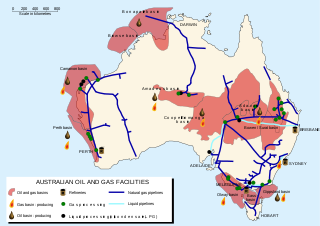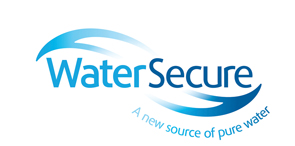The Queensland Water Commission (QWC) is a defunct Queensland Government agency established to develop long term water supply strategies. [1] The Commission was chaired by Mary Boydell and the chief executive officer was John Bradley.
The agency was responsible for setting water restriction policy and coordinating water infrastructure projects in the state. In South East Queensland, the Commission established a regional water grid known as the SEQ Water Grid and the Western Corridor Recycled Water Project. Together with new dams and desalination plants the Commission aimed to counter the worst effects of drought in Australia.
As part of 50-year South East Queensland water strategy the QWC recommended that the Government of Queensland focus on recycled water projects, rather than desalination plants, because desalination plants are too energy intensive and recycled water provides supply regardless of changes in climate. [2]
On 1 January 2013, the Queensland Water Commission ceased operations. Policy-making functions of the Commission were assumed by the Queensland Department of Energy and Water Supply and its planning and regulatory functions became the responsibility of Seqwater. [3]

The Wivenhoe Dam is a rock and earth-fill embankment dam with a concrete spillway across the Brisbane River in South East Queensland, Australia. The dam wall is located about 80 kilometres (50 mi) by road from the centre of Brisbane. The primary purpose of the dam is the supply of potable water for the Brisbane and Ipswich regions. In addition, the dam also provides for flood mitigation control, hydroelectricity and for recreation. The impounded reservoir is called Lake Wivenhoe and the dam, the lake and a narrow strip of surrounding land forms a locality also called Lake Wivenhoe.

The Leslie Harrison Dam is an earth-fill embankment dam across the Tingalpa Creek that is located in the South East region of Queensland, Australia.The main purpose of the dam is for potable water supply of the Redland City in Brisbane. The impounded reservoir is called Tingalpa Reservoir. The dam was named after Robert Leslie Harrison, a Queensland parliamentarian who died in April 1966.

The North Pine Dam is a mass concrete gravity dam with earth-fill embankments on abutments with a gated spillway across the North Pine River that is located in the South East region of Queensland, Australia. The main purpose of the dam is for supply of potable water for the Moreton Bay region and Brisbane's northern suburbs. The impounded reservoir is called Lake Samsonvale.
The Gold Coast Desalination Plant is a 125 ML/d reverse osmosis, water desalination plant located in Bilinga, a seaside suburb of the Gold Coast, in Queensland, Australia. It supplies water to the South East Queensland region via the South East Queensland Water Grid.

The energy policy of Australia is subject to the regulatory and fiscal influence of all three levels of government in Australia, although only the State and Federal levels determine policy for primary industries such as coal.

The Cedar Grove Weir is a weir located across the Logan River in the South East region of Queensland, Australia. The main purpose of the weir is for potable water storage.

Seqwater is a statutory authority of the Government of Queensland that provides bulk water storage, transport and treatment, water grid management and planning, catchment management and flood mitigation services to the South East Queensland region of Australia. Seqwater also provides irrigation services to about 1,200 rural customers in the region that are not connected to the grid and provides recreation facilities.

The Victorian Desalination Plant is a water desalination plant in Dalyston, on the Bass Coast in southern Victoria, Australia. The project was announced by Premier Steve Bracks in June 2007, at the height of the crippling millennium drought when Melbourne's water storage levels dropped to 28.4%, a drop of more than 20% from the previous year. Increased winter-spring rains after mid-2007 took water storage levels above 40%, but it was not until 2011 that storages returned to pre-2006 levels.

Queensland's energy policy is based on the year 2000 document called the Queensland Energy Policy: A Cleaner Energy Strategy. The Queensland Government assists energy development through the Department of Energy and Water Supply. The state is noted for its significant contribution to coal mining in Australia. The primary fuel for electricity generation in the state is coal with coal seam gas becoming a significant fuel source. Queensland has 98% of Australia's reserves of coal seam gas. An expansion of energy-intensive industries such as mining, economic growth and population growth have created increased demand for energy in Queensland.

The Western Corridor Recycled Water Scheme, a recycled water project, is located in the South East region of Queensland in Australia. The scheme that is managed by WaterSecure is a key part of the SEQ Water Grid constructed by the Queensland Government in response to population growth, climate change and severe drought. The A$2.5 billion project is reported as the largest recycled water project in Australia.

The Sydney Desalination Plant is a potable drinking water desalination plant that forms part of the water supply system of Greater Metropolitan Sydney. The plant is located in the Kurnell industrial estate, in Southern Sydney in the Australian state of New South Wales. The plant uses reverse osmosis filtration membranes to remove salt from seawater and is powered using renewable energy, supplied to the national power grid from the Infigen Energy–owned Capital Wind Farm located at Bungendore.
As Australia's supply of freshwater is increasingly vulnerable to droughts, possibly as a result of climate change, there is an emphasis on water conservation and various regions have imposed restrictions on the use of water.
Water security in Australia became a major concern in Australia in the late 20th and early 21st century as a result of population growth, recurring severe droughts, fears of the effects of global warming on Australia, environmental degradation from reduced environmental flows, competition between competing interests such as grazing, irrigation and urban water supplies, and competition between upstream and downstream users.

The Adelaide Desalination plant (ADP), formerly known as the Port Stanvac Desalination Plant, is a sea water reverse osmosis desalination plant located in Lonsdale, South Australia which has the capacity to provide the city of Adelaide with up to 50% of its drinking water needs.

The SEQ Water Grid is a region-wide, long term, water supply scheme that provides a sustainable water infrastructure network for the South East region of Queensland, Australia. The project was the largest urban response to the drought in Australia, which severely affected water supplies in Brisbane and surrounds, particularly between 2004 and 2007. The basic component of the project was a 535-kilometre (332 mi) network of potable bulk water pipelines that connect areas that have an oversupply of water to those areas lacking water. The project went online in October 2008 and by November 2008 parts of the region were receiving a diversified supply of water for the first time.

Australia is the driest habitable continent on Earth and its installed desalination capacity has been increasing. Until a few decades ago, Australia met its demands for water by drawing freshwater from dams and water catchments. As a result of the water supply crisis during the severe 1997–2009 drought, state governments began building desalination plants that purify seawater using reverse osmosis technology. Approximately one percent of the world's drinkable water originates from desalination plants.

LinkWater, the trading name of the Queensland Bulk Water Transport Authority, a former statutory authority of the Government of Queensland was in operation between 2008 and 2012. During this period, the authority was responsible for the management, operation and maintenance of potable bulk water pipelines and related infrastructure throughout South East Queensland, in Australia.

The SEQ Water Grid Manager, a former statutory authority of the Government of Queensland, was in operation between 2008 and 2012. During this period, the agency was responsible for managing the strategic operation of the SEQ Water Grid, including issues such as water security and water quality for the region in a cost-effective manner, while balancing the needs of the community and the environment.

WaterSecure, the trading name of the Queensland Manufactured Water Authority, was a statutory authority of the Government of Queensland that supplied water to the South East Queensland region of Australia through its desalination plant and a water recycling scheme, the Western Corridor Recycled Water scheme. WaterSecure was merged with Seqwater on 1 July 2011.